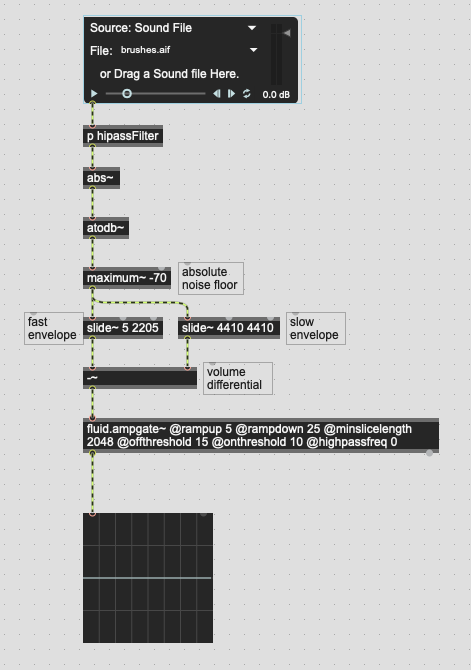So the original (profoundly confusing(!)) fluid.ampslice~ was broken up into two objects in what is now known as fluid.ampgate~-gate.
I had some initial confusion with how fluid.ampgate~ was supposed to work, and after some clarification from @weefuzzy, got something working for the context I needed it in.
Certain things about it are still confusing about it to me, and for the purposes of my patch I’m combining half of the original Max-version of fluid.ampslice~ with the tail end of fluid.ampgate~. Doing something like this:
A bit strange that I have to go “half and half” with it, but not the end of the world.
Today I started thinking about the cool lookahead and lookback features of the original fluid.ampslice~ had, and how those can be used with the separate objects now.
Now, it’s (very(!)) possible that I didn’t understand how that was meant to work in the original version, but my understanding is that, for a bit of extra latency, you could be more certain of where the transient/attack happened. Is that about right?
If so, how does one re-combine the two objets back together in order to do that?
----------begin_max5_patcher----------
785.3ocwVs0bhBCE9Y8WASdVc3V.69j+O1YmcBP.RMlvlDT6zo829lKhEuTq
K1g8EI4vANmuKdHuNcBHiuGKAd+v6mdSl75zISrgLAlbX+DvFz9bJRZSCHy4
M32Ayb2h0tg2pnXk8l9GhRJroxydddRWlMHUdMgU8aANW4JXXzxE9y7hRSMW
Bh7Odw6We79IrtWenI1aSmZ9Y1c1tL7Ncaz0DJ7dasAkzVRwBzllJjB+t2Jg
dYaiWfaUAeGyrVWaIkjioXVkp1KNNv2aEurTUKvxZNsvyegNMNqe.n2pZRUc
itCJE3+34ectJ7RtB1koKM0KMXGQAjjJFhBl4A.GolaPngPykjXKuFF9Y7Yv
.3y+Q4O5FxOLbAzzdv+epuUce+LAaoVjKobtvadpVLKQR0A6QucVKRXnuNjj
x2cHAmCoKfMGWnybRg9wKO02D.OyYEbz2PILbNuko5aa9RyT32jYJHI1bABe
xZsfemloLaYwhtVcKAuaKQRxHTh5E6asCDkkR7gFatsglG0qSn7703hBApRl
K3TZe2Xtl2Wq4UdaUc+3XFJihqu7Ab2X6k2HqZCu.eRDtnP298hbptz09LzF
6yAJva3RsVVrPSDZzCtT3R+Jg6HpQhpCitAqJITrQRyDsxZrbAhTZ1tR6iaz
KBLq2xMpt+cH5wI1IGAVMe4Sell6O.MGoThVB3lzUO13i+FbAcba2ap0kDlZ
gP.z+KFE1Qo5tyU6d+WDLBvL3wfIDNPXxFUTFMLTFG+j8SECEktoyiA.ieL.
NT2Z2WaFCHBGFDSBReHMTOHaMpFiFEeZxigwgJiFLlgxW2Gh1G0dFfyNlts9
l3mha8WWD4cca2nkdC8KvREggTDNqWRPWNWkZu6B4OREBdG0I4anNg2Od5rK
GONviwjQikjEOVEBNVEJYjJz8XNhtt4H3gJb5cT3vK.naLBpoYKVHOjrsD5A
kOyss0xY1sDlaqc5DPfMGH2kejMBRnG6ozy7ZEtyztOw8UOf4zwBldNqCiZv
M0b7a8PXy4ekMHGNrypm91z+Brs5reC
-----------end_max5_patcher-----------
I can picture doing it with the “half and half” version I posted above, where you feed the differential into fluid.ampgate~, but then it’s going through another envelope follower and thresholding stage, which has to have some kind of impact on the signal.
/////////////////////////////////////////////////////////////////////////////////////////////////////////
So in short, the two things I don’t understand how to do after the creation of fluid.ampgate~-gate are:
- How to have a gate output from an incoming signal based on the differential algorithm from
fluid.ampslice~without having to “half and half” things. - How can you leverage the single-sample-spike output of
fluid.ampslice~but with thelookaheadandlookbackfeatures offluid.ampgate~?

